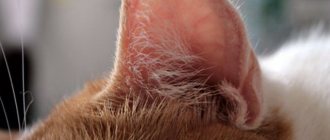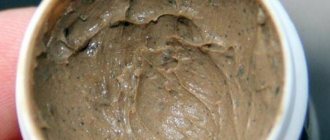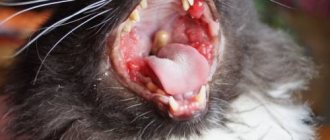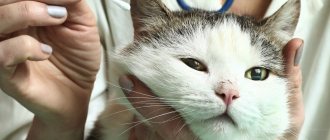Causes of plaque and provoking factors
Brown, dry plaque that turns into a sticky, dark, foul-smelling mass that resembles coffee grounds can occur for several reasons. Regardless of the nature of the occurrence, the presence of an increasing volume of dirty brown substance in the ears is fraught with the occurrence of otitis media and the death of the cat.
The main reasons for the appearance of brown plaque in the ears of a pet:
- ear mite;
- water or foreign body entering the ear canal;
- severe hypothermia;
- old sulfur plug;
- head injury;
- bites, scratches;
- dermatitis of the auricle;
- infectious diseases.
Ear pathologies can occur in any cat, so it is recommended to periodically practice ear hygiene and monitor the health of the auricle.
Most often, provoking factors for the development of the disease are:
- insufficient care;
- keeping in damp, cold rooms or in a draft;
- poor quality feeding;
- chronic and acute infectious and non-communicable diseases;
- vaccination;
- weaning;
- stress;
- lack of vitamins and microelements;
- pregnancy;
- puberty;
- genetic predisposition;
- oncology;
- exhaustion;
- diabetes;
- hormonal disorders;
- decreased immunity;
- heredity.
Symptoms
A tick in a cat's ear will make itself felt literally from the moment it appears.
- The animal begins to show anxiety and try to scratch its ears in any possible way: with its paws, by rubbing against hard surfaces. Constant itching will make her nervous and aggressive. In addition, constant attempts to scratch the ear will lead to scratches and open wounds that may become inflamed and begin to fester, so the itching will intensify. It is impossible to let the disease progress to such a state, as this may result in the eardrum bursting and the inflammation penetrating deeper into the inner ear.
- The cat begins to shake its head frequently, trying to get rid of the cause of scabies in the ear.
- Swelling is observed in the areas where the tick is located due to the fact that the vessels are overflowing with blood.
- On damaged surfaces there is exudate - liquid secretions. When it dries and mixes with skin particles and waste products of mites, brown scabs appear.
- The ear canal becomes crusty and then plugged.
- Even from a distance you can smell an unpleasant odor from a cat's ear.
- At a later stage of the disease, purulent masses stick together the fur at the base of the ear.
- In the later stages of the disease, your cat may experience hearing loss, although this can be difficult to test.
- An indirect sign of ear mites in cats may be fever or lethargy.
Ear mite photo
If any of these signs occur, and especially if they are accompanied by an increase in temperature, you should contact your veterinarian for professional help.
Diseases accompanied by the appearance of brown plaque in a cat’s ears
The most common diseases accompanied by the appearance of brown plaque in the ears of a pet are otodectosis and otitis media. Both pathologies are deadly, but with timely detection and referral to a specialist, they can be treated quite successfully.
Otodectosis
Otodectosis or ear scabies is a parasitic disease caused by microscopic sarcoptoid mites otodectos cynotis. It is impossible to see the parasite with the naked eye; the arthropod measures 0.2-0.5 mm. Carnivorous arachnids parasitize the external auditory canal, eardrum and auricle, feeding on epidermal scales, blood and lymph. To lay eggs, female mites make multiple punctures in the skin and penetrate into the subcutaneous layers.
Where does plaque come from: causes of occurrence
If the kitten has black ears on the inside, but the plaque does not cause discomfort to the pet, it may be the result of increased secretion of earwax. This is typical, for example, for Sphynx cats. This breed completely lacks a mechanism for self-cleaning the ear from wax. Owners need to independently monitor the condition of their pet’s ears and prevent the formation of wax plugs.
The cat's ears are bothering him
The causes of plaque in the ears, as a symptom of the disease, can be different in origin. Below are the most popular ones.
Scabies mite
Ticks of the species Notoedres cati feed on the blood and lymph of animals, living in the upper layers of the pet's skin. They cause a disease called notoedrosis, or pruritic scabies.
Notoedres cati mites cause scabies
The tick is localized in the neck and head of the animal. The disease is easily transmitted from one pet to another if treatment with antiparasitic drugs is not carried out.
- restless behavior, the cat may meow;
- begins to itch periodically;
- hair falls out and bald spots appear;
- the appearance of wounds and ulcers.
Fungal and yeast ear infections
Along with ear mites, fungal infections often occur. Sores with pus or yellow liquid appear inside the animal’s ear, which become covered with scabs after maturation and flow of the liquid. The smell of fungal plaque resembles cheese or mold.
If your animal exhibits symptoms of this disease, you should immediately contact a veterinarian.
Dermatitis and eczema
Various skin reactions of the body manifest themselves as redness and swelling of the ear tissue, accompanied by a local increase in the temperature of the ear surface. Rashes, scabs and ulcers are noticeable on the ear and nearby tissues.
Special cases
Sometimes brown plaque in the ears of a furry pet is not a symptom of otitis media or otodectosis. Particular cases of the appearance of brown matter in a cat’s ears include: plaque in only one ear, a strong nauseating odor from the ears and increased secretion of wax.
Plaque in only one ear
If dark plaque is found in only one ear, and the cat does not refuse food, itching, apathy and redness of the skin, this is simple contamination. The problem can be solved by simply removing the brown deposits using a cotton pad soaked in cleansing lotion. The next day, you need to check for dirt in the ear. If the brown mass reappears, you should contact a specialist.
Pungent, nauseating odor from the ears
Simultaneously with the formation of brown plaque, a sharp unpleasant odor from the ears most often indicates the development of otodectosis or otitis media. In particular cases, a combination of these symptoms is observed with suppuration in the ears, head trauma, neoplasm and food allergies. A veterinarian should be involved in identifying the cause of brown plaque and unpleasant odor.
How to treat ear mites in cats
Before starting treatment for otodectosis in cats, many factors are taken into account:
- Conditions of keeping (does the cat go outside).
- The severity of the condition.
- Presence of other animals at home.
If there are other pets in the house, then general treatment is carried out. Treatment of the premises and objects is not required, since the parasite does not survive well in the environment. There is also no need to change your diet and lifestyle.
It is more effective to treat otodocthesis in a cat that does not go outside and is kept entirely indoors using systemic medications. This is one way to get rid of ticks forever. If the cat is walking and in contact with other animals, parasites are removed with acaricidal preparations that are applied topically.
There is no quick cure for ear scabies in cats. On average, treatment takes 1-1.5 months.
It is important to keep your ears clean throughout your treatment. Otherwise, the cat’s ear mite takes refuge in wax and secretions, and acaricidal agents do not penetrate to the place of refuge.
Cat treatment
A veterinarian should treat a cat with ear pathologies after conducting a comprehensive examination and identifying the cause of the formation of brown plaque. Self-medication is fraught with aggravation of the animal’s condition or the death of your beloved pet.
For otodectosis the following is prescribed:
- mechanical cleaning of the animal’s ears from plaque, pus and dried crusts using disinfectant solutions;
- acaricidal drugs;
- vitamin and immunostimulating agents;
- disinfection of premises and care items;
- treatment of other pets.
When otitis of the external, middle or inner ear is detected, therapy consists of the use of the following drugs:
- disinfectant solutions for cleaning the ear;
- antibacterial and anti-inflammatory drops and ointments;
- painkillers;
- novocaine blockades;
- injectable antibiotics;
- vitamins;
- immunomodulators;
- diet.
Feline otitis media: symptoms and treatment
Otitis is an inflammation of the ear that can occur in cats in different forms and have different symptoms. Diagnostics allows you to establish the exact localization of the pathological process and the reasons that caused it. Depending on this, the veterinarian prescribes conservative treatment using appropriate medications. To prevent otitis media in cats, it is necessary to follow preventive measures, which include proper care of your pet.
Prevention of ear diseases and ear hygiene in cats
Prevention of ear diseases in cats consists of:
- ear hygiene;
- quality care and feeding;
- use of vitamin and mineral supplements;
- timely treatment of infectious and non-communicable diseases;
- avoiding contact with stray and infectious animals.
Ear hygiene in cats involves regularly cleaning the ears from dirt and wax plugs. To do this, you need to wrap your pet in a towel, secure it tightly and drop cleansing lotion into the ear.
For better penetration of the product into the external auditory canal, it is necessary to gently massage the base of the animal’s ear. After the massage, lotion with dirt and sulfur must be removed with a dry cotton swab. The final stage of the hygiene procedure is to reward the cat with her favorite treat.
What to do if your cat has black dirt in his ear and itches
A disease caused by a tick.
Treatment may be prescribed depending on the severity of the disease. If the owner has only recently noticed the appearance of a black plaque that the cat has not had before, you can buy the necessary drops or aerosols at a veterinary pharmacy and treat the animal yourself. If there are obvious complications in the form of bruises, scratched ears and inflammation, only a veterinarian can provide assistance. If the cat breed has an unusual ear structure (for example, Sphynx), wax plugs may become the No. 1 problem that the owner will have to face.
It accumulates in large volumes, does not clean itself and becomes a favorable environment for various microbes.
Sulfur itself does not cause any discomfort to the pet, but the presence of bacteria can greatly darken the cat’s life. To prevent inflammation, it is enough to carefully clean your cat's ears of wax plugs at least once a month. To remove large plaque deposits, it is better to purchase a special lotion from a veterinary pharmacy. If the remedy does not produce results, contact a veterinarian immediately.
A disease that requires a serious response from the cat owner. Otitis can be external, medial and internal.
With external otitis, the symptoms are the same as with a tick - a dark coating in the ears and restless behavior of the cat, when it often scratches its ears, as if trying to remove something from there.
The next stage of the disease is medial otitis, which is more difficult to cure than external otitis. At this stage, you need to urgently contact a veterinary clinic.
With medial otitis, signs such as:
- discharge of fluid from the ears;
- an unpleasant odor is felt from a distance;
- change in the cat’s behavior, she does not allow her ears to be touched;
- refusal to eat.
Cats have excellent hearing and pleasantly surprise owners with their abilities. In order for your pet to always remain healthy and not experience problems with the ears, it is necessary to periodically examine them.
When your four-legged pet has brown plaque in its ears, you should first of all rule out the possibility of an ear disease.
If brown discharge in a cat's ears is accompanied by other painful symptoms, it means the pet is sick.
In some cases, the cause of plaque in the ears is ear mites. Parasites live in the ear and external meatus, causing inflammation. A cat can pick up ticks through contact with other pets or while outdoors. When otodectosis occurs, dark discharge forms in a cat's ears; in severe cases, plaque accumulates on the outer part of the ear.
Otitis externa is another reason why brown dirt appears in a cat's ears. In this case, redness or swelling of the ear canal occurs.
The cat becomes irritable or, on the contrary, becomes depressed. When the ears are touched, the animal experiences pain. In the case of external otitis, the pet sometimes shakes its head or tilts the sore ear towards the floor.
A brown plaque with an unpleasant odor appears in the middle of the ear.
When an infection gets into the ear canal or the eardrum is damaged by a foreign object, otitis media sometimes occurs. The disease is much more dangerous than the external form of otitis. You can find out about inflammation of the middle or inner ear by purulent discharge from the ear cavity. Another sign of the disease is the appearance of problems with balance, gait or jumping in the cat.
Bacteria and yeast can cause ear infections.
In the presence of favorable factors (moisture, disturbances in the functioning of the body), bacteria quickly multiply and cause discomfort in the pet. It is possible to identify the presence of pathology by the cat’s behavior.
The animal behaves restlessly. Ear infections can be caused by hormonal imbalances, allergies, or genetic diseases.
If something brown appears in a cat's ears, this does not always indicate that the pet is sick. Such plaque may be ordinary sulfur plugs. It is necessary to examine the cat's ear cavity once a week, and also clean the ears once every two weeks to combat dirt. It will not be difficult to cope with such a task, armed with ordinary ear sticks.
Ear cleaning is best done by adhering to the following rules:
- First of all, you need to wrap your pet in a towel so that he does not scratch during the procedure. It is best to talk to the cat during the cleaning process, so the pet will calm down faster;
- Use cotton swabs, napkins and olive oil. When cleaning the ear cavity, you must be as careful as possible so as not to damage the integrity of the eardrum;
- If the wax plugs have already dried out, then you need to dip a cotton swab in a small amount of olive oil and then lubricate the inside of the ear. At the final stage, it is recommended to wipe the ears with a napkin.
Chlorhexidine can be used as a disinfectant solution.
Preventing ear diseases is not difficult. It is enough to regularly inspect the ear cavity for mites, foreign objects and plaque. Do not forget that a small amount of brown discharge may be present in your pet’s ears - this is considered normal.
In the case when, in addition to the brown plaque, the pet is also bothered by other symptoms that cause him discomfort, you should be more careful. If there is an unpleasant odor coming from the auricle and the hearing organ looks unhealthy, this is a reason to take the cat to the veterinarian.
Drops are very helpful in fighting ear infections. Before using the medicine, it is important to clarify the correct dosage of the drug and treatment regimen. If you first study the instructions on the package, it will not be difficult to make the treatment effective.
We invite you to read: How dangerous are fleas to humans? What diseases can fleas carry?
When applying the drops, you must be careful when handling your cat's ears. First, the ear should be slightly bent and drops should be dripped into the lower area of the ear canal. It is recommended to massage the base of the ear to help the medicine spread throughout the canal.
After all the manipulations, you should treat your pet with a treat.
In this article I want to tell you why black dirt appears in a cat’s ear, symptoms of what diseases it can be, and how to treat these diseases if the animal is constantly itching. And most importantly, I’ll tell you how to avoid any problems with your pet’s ears and hearing through prevention.
Every owner of a cat or small kittens has at least once encountered the fact that brown dirt accumulates in the ears of his pet. The reasons for this vary from the fact that the cat simply got dirty somewhere, to quite serious diseases, such as otodectosis.
But even if the problem is just that the cat was unable to wash her ears (and it is difficult for her to reach them), this does not mean that everything can be left as is. It is urgent to remove accumulated dirt.
You need to do this:
- Pre-wrapping the cat in a towel or blanket
- Soaking dried dirt with Vaseline or vegetable oil
- Using cotton swabs for babies to remove
Under no circumstances should you clean your ears using water.
If you find brown dirt again, then, unfortunately, we are faced with a sign of more serious problems, which I will discuss below.
Before cleaning the ears, the dirt must be soaked and cotton swabs for babies should be used.
The dirt that owners find in their cat's ears is not always brown. Often its color is closer to black. The presence of a substance of this color in the ear means that the cat is most likely sick.
What exactly depends on the symptoms, but there are three main problems that almost every pet owner can face.
Otodectosis
This disease is caused by one of the most common parasites of cats - ear mites. Ear mites are arthropods that inhabit almost all ear canals and multiply rapidly.
It first settles in the outer ear. Having completely colonized it, the mite begins to colonize the medial and internal canals.
It is quite simple to determine that your cat has otodectosis - the brown plaque continues to accumulate even after its removal, which is why treatment must be started immediately.
Each of them is characterized by its own symptoms:
- During the initial phase, the mass released from the shell is dry, like the surface of the ear itself. There is no scratching.
- At an advanced stage, the mass becomes more viscous, the ear becomes inflamed due to the appearance of colonies of fungi and bacteria.
Ear mite
When treating the first stage of the disease, it is enough to use Otodexin ear drops, aerosols and lotions. And the second requires the use of antibiotics and antimycotic agents.
At any stage of the disease, before starting the procedures, it is necessary to remove the plaque and crust that has formed on the surface of the ear.
Attention! When complexly treating all animals in an apartment, you need to know that only cats react painlessly to ivermectin drops. Dogs may be intolerant to it. Small animals should not be treated with this remedy either.
In order for the cat to behave quietly during the procedure, the instilled liquid must be slightly warmed up.
A remedy for ear mites in cats can also be in the form of ointments and aerosols. Aversectin ointment with acaricidal action is applied to the ear with a special spatula and is absorbed by gently massaging it.
Preventive measures
Preventing ear diseases is not difficult. It is enough to regularly inspect the ear cavity for mites, foreign objects and plaque. Do not forget that a small amount of brown discharge may be present in your pet’s ears - this is considered normal.
In the case when, in addition to the brown plaque, the pet is also bothered by other symptoms that cause him discomfort, you should be more careful. If there is an unpleasant odor coming from the auricle and the hearing organ looks unhealthy, this is a reason to take the cat to the veterinarian.
Drops are very helpful in fighting ear infections. Before using the medicine, it is important to clarify the correct dosage of the drug and treatment regimen. If you first study the instructions on the package, it will not be difficult to make the treatment effective. When applying the drops, you must be careful when handling your cat's ears. First, the ear should be slightly bent and drops should be dripped into the lower area of the ear canal. It is recommended to massage the base of the ear to help the medicine spread throughout the canal. After all the manipulations, you should treat your pet with a treat.
To effectively combat ear pathologies, in addition to drops, tablets, powders and injections can also be used. If you carefully monitor the condition of your cat’s ear cavity and maintain hygiene, many problems can be eliminated at the initial stage.
Other causes of dirty ears
Some cat breeds have large ears, which are natural dust collectors. But even in an ordinary ear, dust accumulates over time and settles in the auricle. If too much dirt accumulates, the animal’s internal defenses come into play. This consists in increased secretion of earwax and, as a result, the formation of a dirty mass.
In some cases, the intensity of the work of the cerumen gland does not depend on external stimuli, so dirty ears can occur in cats that are constantly in a clean house. Most often, this phenomenon affects breeds that have no or little hair on their ears, but this is the animal’s natural protection from external influences. These ears need to be cleaned regularly.
Why does my cat's ears smell?
It should be immediately mentioned that normally there should be no unpleasant odor coming from the animal’s ears. The main reason for this phenomenon can be safely called the development of inflammation of the auditory canal (otitis externa), accompanied by the proliferation of pathogenic microorganisms and the formation of various secretions.
Due to the structural features, all problems with the ears of animals are classified as dermatological, that is, skin diseases. As a rule, it all starts with the formation of excess sulfur secretion. This can be either a physiological feature of the cat, when the ear glands produce excessive amounts of wax, or a consequence of other problems.
Allergy
For example, it is common for a cat to have smelly ears due to an allergic reaction, when inflammation and swelling in the ear canal appear as a result of the animal’s reaction to an allergen in the environment or food. A predisposing factor may be a violation of the normal removal of ear secretions, which is especially important for fold-eared cats.
Accumulated earwax becomes an excellent substrate for the proliferation of microorganisms, including yeast-like fungi and bacteria. They often jointly populate the ear canal, causing discharge from the ears (even purulent), inflammation, severe itching and pain. As a result, the ears begin to smell unpleasant.
Other causes of odor
In addition, the reasons why a cat’s ears smell can be:
- neoplasms in the auditory canal;
- gland cysts;
- inflammation due to injury (including due to improper ear cleaning);
- entry of a foreign body into the auditory canal;
- systemic disease (for example, otitis often occurs against the background of hypothyroidism);
- ectoparasites.
Tick-borne otitis media
Ectoparasites include microscopic mites that parasitize the skin of pets. Unlike other types of diseases, tick-borne otitis media is contagious and is transmitted from cat to cat, so the chance of contracting it increases many times over if the animal goes outside. Mites of the genera Demodex, Notoedres, Sarcoptes, but most often Otodectes are found in the ear canals.
At the same time, cats feel severe itching, scratch their ears and shake their heads, and dark and thick discharge resembling coffee grounds accumulates in the ear canal. All this is often accompanied by bacterial and fungal infections, which aggravates inflammation and leads to the appearance of an unpleasant odor.
Causes
The appearance of black plaque in the ears of cats is a very common phenomenon that cannot be considered harmless for the animal. In addition, the pet experiences severe discomfort. The disease has a name - otodectosis (ear scabies). Its appearance is provoked by a parasite such as an ear mite. It is also a mistaken opinion that only a street animal can catch the disease, but not a domestic one. Absolutely any cat can get sick, even if it is constantly kept in sterile conditions. Even the owner can bring the parasite into the house when he comes in from the street, without even suspecting that there is an ear mite on his sole.
When an animal begins to develop otodectosis, the disease is accompanied by the following characteristic symptoms, which the owner must pay attention to:
- The animal behaves very restlessly, shakes its head and constantly scratches its ears, trying to get its paw into it. Very often you can hear something squelching in your ear. Such symptoms are also characteristic of the onset of otitis media, so when they appear, it is necessary to urgently take the cat to a veterinarian who can determine the reason for this behavior of the pet.
- Ear mites reproduce so actively that two weeks after the animal becomes ill, the owner can already see it. To do this, you need to carefully pick up the cat and stroke it so that it calms down and is not afraid. And then wrap her ear and examine the inside of the ear. If you see a black coating on a kitten’s ears, ear mites have definitely multiplied there.
- If the disease has already reached an advanced stage, then dried crusts appear in the cat’s ears. This is the result of the fact that the animal cannot tolerate severe itching and tries to scratch the ear from the inside, thereby tearing it apart into wounds and trying to remove the parasites from there on its own.
The main thing here is not to launch. Otherwise, both the animal and the owner will suffer from constant cleaning of the ears.











